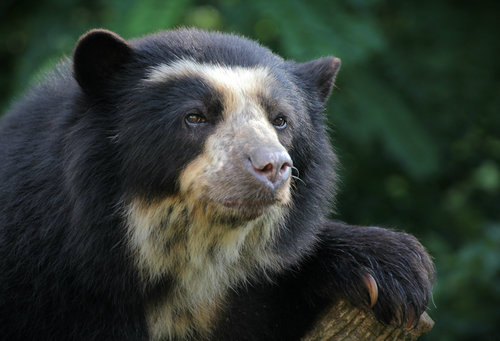
Andean Bear
Tremarctos ornatus, or the Andean bear, thrives in the Andes' lush cloud forests. Known for its unique facial markings, this elusive bear aids in ecosystem balance through seed dispersal, embodying a vital ecological role. Its striking 'spectacled' appearance captivates and distinguishes it in the wild.
20-30 years
Lifespan
130.0 - 200.0 kg
Weight
Height: 1.5 - 2.0 m
Size
Grey, Black, White
Color
30 mph
Top Speed
Vulnerable
Conservation Status
Decreasing
Population Trend
Characteristics
The Andean bear, known scientifically as Tremarctos ornatus, is the only bear species native to South America. It inhabits the cloud forests of the Andes Mountains, displaying distinct black fur with creamy markings around its eyes, resembling glasses. This omnivorous bear plays a crucial role in seed dispersal and forest ecology.
Distribution Range of the Andean Bear
Tremarctos ornatus, commonly known as the Andean bear or spectacled bear, is native to the Andean region of South America. Its geographical distribution includes countries such as Venezuela, Colombia, Ecuador, Peru, Bolivia, and parts of northwestern Argentina. The species primarily inhabits the Andean mountain range, with a range extending from the northern to the southern sections of the continent.
Andean Bear's Habitat
Environmental Conditions
The Andean bear typically inhabits cloud forests, high-altitude grasslands, and montane forests. These environments are characterized by high humidity, dense vegetation, and frequent fog or cloud cover. The bears are found at elevations ranging from 1,800 to 4,500 meters, although they can occasionally be found at lower elevations.
Ecological Niche
Tremarctos ornatus is a primarily herbivorous species, although it has an omnivorous diet that includes fruits, bromeliads, and small animals. The Andean bear plays a crucial ecological role as a seed disperser due to its feeding habits. Adaptations to its habitat include its ability to thrive in both wet and dry seasons, and it is known to migrate across different elevations in search of food and suitable conditions.
Copyright @ Nature Style Limited. All Rights Reserved.
 English
English